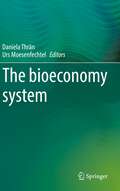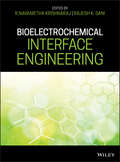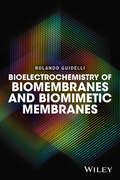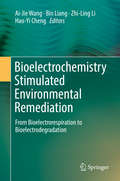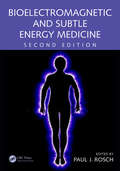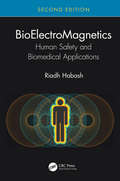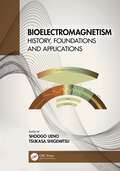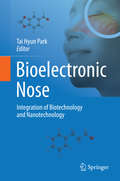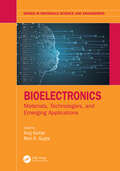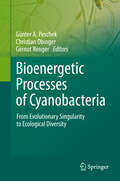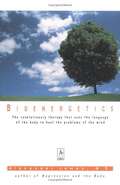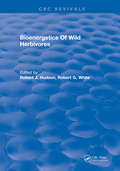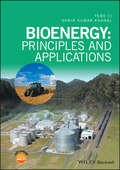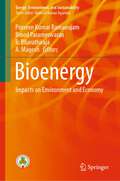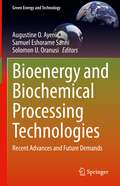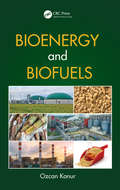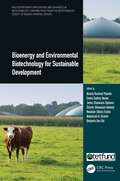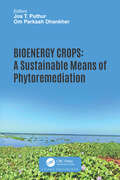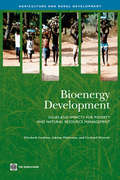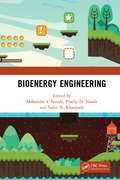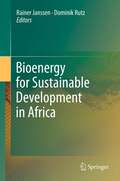- Table View
- List View
Bioeconomy of Streptomyces
by Kashyap Kumar Dubey Punit KumarThis book provides a comprehensive understanding of streptomycetes, highlighting their various habitats, diversity, genetic structure, and metabolic engineering techniques to enhance the production of secondary metabolites. It also presents techniques for the isolation, cultivation, biochemical identification, chemotaxonomy, and phylogenetic analysis of streptomycetes. The book explores the production of bioactive compounds from streptomycetes, including novel natural products, antimicrobial agents, pharmaceuticals, medicinal compounds, and bioactive enzymes. Furthermore, the book examines the diverse applications of streptomycetes in agriculture, medicine, industry, and bioremediation. The chapters emphasize the latest technological advancements such as bioprocess optimization, genetic engineering, metabolic engineering, genome mining, and pathway engineering for enhancing the production of secondary metabolites from Streptomyces. As such, this book is of interest to academicians, researchers, and professionals working in the fields of bioprocessing, microbiology, industrial microbiology, medical microbiology, fermentation technology, and biotechnology.
The bioeconomy system
by Daniela Thrän Urs MoesenfechtelThis book is a concise overall view of the status quo of the bioeconomy and its future developments - in Germany and beyond. Numerous practitioners from business, science, civil society and politics show how the bioeconomy is addressing the global problems of the future. Based on renewable raw materials and energies, the bioeconomy is developing new products and processes with the aim of shaping a more ecologically and economically sustainable future. But can it succeed? What are its opportunities and limitations? Which framework conditions influence it? The book answers these questions with a systemic view of the bioeconomy and thus enables a quick orientation in this topic. This is additionally supported by numerous graphics. The book thus invites readers to help shape the future of the bioeconomy.
Bioelectrochemical Interface Engineering
by Rajesh K. Sani R. Navanietha KrishnarajAn introduction to the fundamental concepts and rules in bioelectrochemistry and explores latest advancements in the field Bioelectrochemical Interface Engineering offers a guide to this burgeoning interdisciplinary field. The authors—noted experts on the topic—present a detailed explanation of the field’s basic concepts, provide a fundamental understanding of the principle of electrocatalysis, electrochemical activity of the electroactive microorganisms, and mechanisms of electron transfer at electrode-electrolyte interfaces. They also explore the design and development of bioelectrochemical systems. The authors review recent advances in the field including: the development of new bioelectrochemical configurations, new electrode materials, electrode functionalization strategies, and extremophilic electroactive microorganisms. These current developments hold the promise of powering the systems in remote locations such as deep sea and extra-terrestrial space as well as powering implantable energy devices and controlled drug delivery. This important book: • Explores the fundamental concepts and rules in bioelectrochemistry and details the latest advancements • Presents principles of electrocatalysis, electroactive microorganisms, types and mechanisms of electron transfer at electrode-electrolyte interfaces, electron transfer kinetics in bioelectrocatalysis, and more • Covers microbial electrochemical systems and discusses bioelectrosynthesis and biosensors, and bioelectrochemical wastewater treatment • Reviews microbial biosensor, microfluidic and lab-on-chip devices, flexible electronics, and paper and stretchable electrodes Written for researchers, technicians, and students in chemistry, biology, energy and environmental science, Bioelectrochemical Interface Engineering provides a strong foundation to this advanced field by presenting the core concepts, basic principles, and newest advances.
Bioelectrochemistry of Biomembranes and Biomimetic Membranes
by Rolando GuidelliInvaluable to biochemists, biophysicists, and pharmacological scientists; this book provides insights into the essential principles required to understand why and how electrochemical and electrophysiological tools are fundamental in elucidating the mode of ion transport across biomembranes.* Describes the essential electrochemical basics required to understand why and how electrochemical and electrophysiological tools are fundamental in elucidating the mode of ion transport across biomembranes* Requires only basic physical chemistry and mathematics to be understood, without intermediate stumbling blocks that would discourage the reader from proceeding further* Develops contents in a step-by-step approach that encourages students and researchers to read from beginning to end
Bioelectrochemistry Stimulated Environmental Remediation: From Bioelectrorespiration to Bioelectrodegradation
by Ai-Jie Wang Bin Liang Zhi-Ling Li Hao-Yi ChengThis book reviews the latest advances in the bioelectrochemical degradation of recalcitrant environmental contaminants. The first part introduces readers to the basic principles and methodologies of bioelectrochemical systems, electron-respiring microorganisms, the electron transfer mechanism and functional electrode materials. In turn, the second part addresses the bioelectrochemical remediation/treatment of various environmental pollutants (including highly toxic refractory organics, heavy metals, and nitrates) in wastewater, sediment and wetlands. Reactor configuration optimization, hybrid technology amplification and enhanced removal principles and techniques are also discussed.The book offers a valuable resource for all researchers and professionals working in environmental science and engineering, bioelectrochemistry, environmental microbiology and biotechnology.
Bioelectromagnetic and Subtle Energy Medicine
by Davis LangdonBioelectromagnetic and Subtle Energy Medicine focuses on a wide variety of evidence-based bioelectromagnetic and subtle energy therapies for disorders ranging from cancer, cardiomyopathy, and Parkinson's disease to depression, anxiety, and pain. Since publication of the first edition more than a decade ago, there have been so many advances in these
BioElectroMagnetics: Human Safety and Biomedical Applications
by Riadh HabashThis book is an educational resource of evolving scientific knowledge in the area of bioelectromagnetics that may serve the interests of students and decision-makers, as well as society as a whole. It is distinguished by extensive descriptions of fundamental biophysical concepts and their relevance to human health. Reflecting the transdisciplinary approach from several different intellectual streams including physics, biology, epidemiology, medicine, environment, risk science, and engineering, the book is quite a venture into the battling studies to assess the latest research on health effects and biomedical applications of EM energy. This new edition of the book particularly looks at the potential threats from the emerging 5G wireless networks, which will deploy large numbers of low-powered smartphones, notebooks, tablets, radio access networks, and other transmitters. Features Introduces necessary biophysical principles of EM fields in the context of their interaction with living systems. Strengthens understanding of cutting-edge research on several major areas in the broad area of bioelectromagnetics. Presents safety standards and guidelines for human exposure to EM fields. Discusses techniques that have been developed to ensure adequate EM-thermal dosimetry required for both health effects and biomedical applications. Provides insight into the determinants of EM health risk assessment and public concerns. Includes extensive reference list at the end of each chapter to enhance further study. Riadh Habash is a special appointment professor and McLaughlin Research Chair in Electromagnetic Fields and Health at the University of Ottawa, Canada. He has been the recipient of many awards, including the National Wighton Fellowship Award, and has authored or co-authored over 90 research articles, six books, and five book chapters. His most recent books are Green Engineering in 2017 and Professional Practice in 2019 (CRC Press), with the remaining previous books targeting the area of bioelectromagnetics.
Bioelectromagnetism: History, Foundations and Applications
by Shoogo UenoBioelectromagnetism has been gradually developing and expanding into a variety of fields in engineering, biomedical engineering, life science, medicine and biology. Bioelectromagnetism: History, Foundations and Applications provides an overview of the field and its developments; from its inception and growth through the twenty-first century, to the latest advances in electro- and magnetobiology and hazard evaluations of electromagnetic fields.It is organized into three sections, each focusing on specific regions of bioelectromagnetism. It begins with the foundations of the field and its history, with a chronological treatment of the major subjects in bioelectromagnetism. The relationship between atmospheric electromagnetic phenomena, geomagnetism and biological systems are presented. It then discusses the many benefits of bioelectromagnetism: electroreception, magnetic navigation, magnetic sense and magnetic responses of plants, birds, animals and humans. It then moves on to human health issues and the impact of bioelectromagnetism. It also provides practical guidance on how to set safety guidelines. Finally, it looks forward to the future prospects of the field based on the latest research in the field.In exploring both the history of the field and the latest developments in today’s research advances, this book provides a comprehensive and self-contained treatment on the subject, which will be a valuable reference for researchers in biophysics, medicine, electrical engineering and biomedical engineering.It can be used as a companion to the editor’s previously published books: Biomagnetics: Principles and Applications of Biomagnetic Stimulation and Imaging (9781482239201, 2016, CRC Press); and Bioimaging: Imaging by Light and Electromagnetics in Medicine and Biology (9780367203047, 2020, CRC Press).Key Features: Provides both a historical view of the field, along with the latest developments in the field Contains practical guidance for researchers on how to set safety guidelines for those working in the area Edited by authorities in the field, with chapter contributions from specialists
Bioelectronic Nose: Integration of Biotechnology and Nanotechnology
by Tai Hyun ParkThe "bioelectronic nose", the device which has a similar function to the human smell sensing system, can be realized by combining the olfactory cells or receptors with nanotechnology. In the last two decades, much has been learned about the smell sensing mechanism in biological systems. With knowledge about the biological olfactory system and the techniques for the expression of biological receptor proteins, we are able to utilize biological materials and systems to mimic the biological olfactory system. In addition to the advances in biological and biotechnological area, nanotechnology has progressed to a great degree. The bioelectronic nose is a good example of the integration of biotechnology and nanotechnology. This book describes basic biological sciences of the olfactory system, biotechnology for the production of olfactory biological elements, and nanotechnology for the development of various sensing devices. The purpose of this book is to provide the reader with a concept, basic sciences, fundamental technologies, applications, and perspectives of the bioelectronic nose.
Bioelectronics: Materials, Technologies, and Emerging Applications (Series in Materials Science and Engineering)
by Anuj Kumar Ram K. GuptaBioelectronics is emerging as a new area of research where electronics can selectively detect, record, and monitor physiological signals. This is a rapidly expanding area of medical research, that relies heavily on multidisciplinary technology development and cutting-edge research in chemical, biological, engineering, and physical science. This book provides extensive information on the (i) fundamental concepts of bioelectronics, (ii) materials for the developments of bioelectronics such as implantable electronics, self-powered devices, bioelectronic sensors, flexible bioelectronics, etc, and (iii) an overview of the trends and gathering of the latest bioelectronic progress. This book will broaden our knowledge about newer technologies and processes used in bioelectronics.
Bioelectrosynthesis (Advances in Biochemical Engineering/Biotechnology #167)
by Falk Harnisch Dirk HoltmannThis volume discusses both the latest experimental research in bioelectrosynthesis and current applications. Beginning with an introduction into the “electrification of biotechnology” as well as the underlying fundamentals, the volume then discusses a wide range of topics based on the interfacing of biotechnological and electrochemical reaction steps. It includes contributions on the different aspects of bioelectrochemical applications for synthesis purposes, i.e. the production of fine and platform chemicals based on enzymatically or microbially catalyzed reactions driven by electric energy. The volume finishes with a summary and outlook chapter which gives an overview of the current status of the field and future perspectives. Edited by experts in the field, and authored by a wide range of international researchers, this volume assesses how research from today’s lab bench can be developed into industrial applications, and is of interest to researchers in academia and industry.
Bioenergetic Processes of Cyanobacteria: From Evolutionary Singularity to Ecological Diversity
by Christian Obinger Gernot Renger Guenter A. PeschekThis publication is unique among a number of books on cyanobacteria because it focuses on the bioenergetics of these widespread organisms which are the evolutionary prerequisite for the development of all higher forms of life on our "blue" planet. The book primarily addresses questions of energy conversion by the fundamental bioenergetic processes: (oxygenic) photosynthesis, (aerobic) respiration, and (anaerobic) fermentation which uniquely occur together in these prokaryotic cells. Thermophilic cyanobacteria offer the most suitable material for high resolution structure analyses of Photosystem I and II and other electron transport complexes by X-ray crystallography (for example, at present the structure of Photosystem II at atomic resolution is only known for these organisms). These achievements during the last decade represent a milestone in our understanding of the complexes which are crucial for solar energy exploitation through photosynthetic water splitting. The present work represents an ambitious attempt to achieve the goal of a synoptic state-of-the-art picture by casting together the mosaics of detailed knowledge described by leading experts in the field. It contains 24 chapters written by 35 authors from Europe, USA, India and Japan. The book is aimed at reaching a broad audience ranging from students to experienced scientists. The editors wish all readers a pleasant and stimulating journey through the fascinating "world" of the bioenergetics of cyanobacteria and sincerely hope that this book will not only be of great value for the experts but also entice young people into this exciting research area with the aim to address successfully the challenging problems of high relevance that are still waiting for a satisfactory answer.
Bioenergetics: A Bridge across Life and Universe
by Davor JureticBioenergetics deals with the very first energy transformation steps performed by living cells. Increased dissipation is the primary effect of processing external energy packages. Enzyme-supported charge separation is the minor but essential outcome for maintaining life. This book explores the usefulness of dissecting the entropy production of enzymes involved in cellular defenses, fermentation, respiration, and photosynthesis, assuming that tightly regulated dissipation is the hallmark of life. Researchers, educators, and students of life sciences can find in this text many examples of how we can use the interdisciplinary approach to study cells' virtuoso ability to connect the microscopic to the macroscopic world. Each chapter is a self-contained unit with a glossary and selected references for further reading.
Bioenergetics: The Revolutionary Therapy That Uses The Language Of The Body To Heal The Problems Of The Mind (Compass Ser.)
by Alexander LowenBioenergetics is the revolutionary new therapy that uses the language of the body to heal the problems of the mind. This exciting body-mind approach to personality has a liberating and positive effect on emotional, physical, and psychic distress. Dr. Alexander Lowen, founder and prime mover of this fast-growing therapy, writes that increased joy and pleasure are possible in every day life through an understanding of how your body functions energetically: how it determines what you feel, think, and do. Dr. Lowen points out that lack of energy is the result of chronic muscular tensions, a condition caused by the suppression of feelings. <P><P>These tensions can be dissolved through the direct body work in bioenergetic exercise, which restores the potential for living a rich, full life. Dr. Lowen analyzes common physical ailments like headaches and lower back pain and shows how they too can be overcome by releasing the muscular tenstion that create them. Generously illustrated with line drawings of bioenergetic exercises, this book is sure to bring freedom, confidence, and pleasure to thousands of men and women. <P><P>"In this highly interesting and valuable attempt to restore the body to the mind, Dr. Alexander Lowen sets out in a practically useful way the principles of his new form of psychotherapy. Bioenergetics is destined to become widely influential."
Bioenergetics Of Wild Herbivores
by Robert J. HudsonBioenergetics is an emerging discipline which offers a more profound understanding of the ecology, behaviour, and evolution of wild herbivores. Increasingly, bioenergetic principles have been applied in management since they provide insight into population dynamics and are relevant to manipulation of habitats and assessment of the impacts of resource development. Growing interest in the agricultural potential of wild herbivores has provided further impetus. In spite of this promise, there are few comprehensive syntheses of the concept and its application to wild herbivores. This volume attempts to fill this need. This book provides a great amount of detail but its expressive aim is to lead us to the whole animal, to a herd, to population as integral parts of an ecological entity which in turn is the result of evolutionary forces.The concept of this book promises the realization of an overdue change in the approach to bioenergetics, to nutrition and husbandry, and thus to the management of wild herbivores: the final emancipation from rules and views based primarily on domesticated herbivores or on experimental animals held under unnatural conditions, necessarily impending them behaviourally, physically, and psychically.
Bioenergy: Principles and Applications
by Samir Kumar Khanal Yebo LiThe search for altenative, renewable sources of fuel and energy from plants, algae, and waste materials has catalyzed in recent years. With the growing interest in bioenergy development and production there has been increasing demand for a broad ranging introductory text in the field. Bioenergy: Principles and Practices provides an invaluable introduction to the fundamentals of bioenergy feedstocks, processing, and industry. Bioenergy provides readers with an understanding of foundational information on 1st, 2nd, and 3rd generation biofuels. Coverage spans from feedstock production of key energy sources such as grasses, canes, and woody plants through chemical conversion processes and industrial application. Each chapter provides a thorough description of fundamental concepts, definitions of key terms, case studies and practical examples and exercises. Bioenergy: Principles and Practices will be an essential resource for students, bioengineers, chemists, and industry personnell tying key concepts of bioenergy science to valuable real world application.
Bioenergy: Impacts on Environment and Economy (Energy, Environment, and Sustainability)
by Praveen Kumar Ramanujam Binod Parameswaran B. Bharathiraja A. MageshThis contributed volume discusses the impact of bioenergy on the environment and economy. The book contents include contributions on themes, such as the impact of emulsified biofuels on the environment, environmental impacts of the current uses of biomass energy, sustainable development in ecosystem, trends in microbial fuel cells and the ecological and economic impacts on biofuel production, among others. The book also uses visual elements to aid learning. This book is a valuable, hands-on resource for researchers, academics and industry professionals, who are interested in alternative fuels, sustainability, clean energy, biofuel production, waste management, environmental pollution, renewable energy and allied fields.
Bioenergy and Biochemical Processing Technologies: Recent Advances and Future Demands (Green Energy and Technology)
by Augustine O. Ayeni Samuel Eshorame Sanni Solomon U. OranusiThis book presents novel techniques, current trends, and cutting-edge technologies in energy and biochemical processes. The authors explore recent advances that solve challenges related to the implications and commercialization of these processes by introducing new techniques or modifying existing technologies to meet future demands for food materials, bioproducts, fossil fuels, biofuels, and bioenergy. Divided into three parts, the first section of the book addresses issues related to the utilization and management of energy towards the efficient characterization and conversion of wastes or raw-/bio- materials to useful products. The second section focuses largely on studies on molecular detection of analytes, purification, and characterization of products recovered from biochemical, enzymatic, food, and phytochemicals, as well as biostimulation and bioaugmentation processes. The final section discusses areas related to heat and mass transfer, fuel processing technologies, nanofluids, and their applications.
Bioenergy and Biofuels
by Ozcan KonurThis book aims to inform readers about the recent developments in bioenergy and biofuels covering current issues from an interdisciplinary approach. It will also feature coverage of anticipated future trends related to each particular biofuel. Chapters will consist of original research presented by world class experts in their respective fields. A number of interdisciplinary areas will be incorporated such as Energy & Fuels, Biotechology, Genomics, Economics, Optimization, Chemical Engineering, Mechanical Engineering and Algae Science. Examples will relate to a matrix of biofuel and energy types such as bioethanol, biobutanol, and biomethane.
Bioenergy and Environmental Biotechnology for Sustainable Development (Multidisciplinary Applications and Advances in Biotechnology)
by Akinola Rasheed PopoolaThis book covers a range of important topics on environmental remediation, biofuels and value-added microbial products for environmental clean-up, water and wastewater recycling and sustainable wastewater treatment using microalgae. Designed to document advances in biotechnology, this book highlights bio-resource utilization in fostering low-carbon renewable energy-based economies and provides new insights into chlorine disinfectant usage in water treatment, wastewater treatment using microalgae, etc. The book will be useful reference material for scientists and researchers in the fields of microbial biotechnology and bioremediation, environmental biotechnology and sustainable development, climate change mitigation, provision of safe water and sustainable wastewater recycling. Emphasizes recent advances in bioremediation techniques towards environmental sustainability Provides detailed information on how to harness indigenous bio-resources including microorganisms as bioenhancement agents for environmental remediation Introduces new frontiers in the area of wastewater treatment using microalgae — important for sustainability and water safety Reviews biotechniques that could enhance higher levels of sustainability in heavily polluted environments and also provides an intelligent monitoring system for waste recycling and environmental remediation, and fostering a low-carbon renewable energy–based bioeconomy Discusses the need for review of existing guidelines on chlorine disinfectant usage for enhanced water quality Akinola Rasheed Popoola, Ph.D., is a Professor of Plant Pathology and the Director of the Biotechnology Centre, Federal University of Agriculture, Abeokuta, Nigeria. Emeka Godfrey Nwoba, Ph.D., is a research scholar at the Algae Research & Development Centre, Murdoch University, Western Australia. James Chukwuma Ogbonna, Ph.D., is a Professor of Microbiology and Biotechnology and Director, National Biotechnology Development Agency, South East Zonal Biotechnology Centre, University of Nigeria, Nsukka, Nigeria. Charles Oluwaseun Adetunji, Ph.D., is an Associate Professor of Microbiology and Biotechnology, and Director of Intellectual Property and Technology Transfer, Edo State University, Uzairue, Nigeria. Nwadiuto (Diuto) Esiobu, Ph.D., is a Professor of Microbiology and Biotechnology at Florida Atlantic University, Boca Raton, FL, USA, and the President and Founder of Applied Biotech Inc. and ABINL, Abuja, Nigeria. Abdulrazak B. Ibrahim, Ph.D., is a Capacity Development Expert at the Forum for Agricultural Research in Africa (FARA) and an Associate Professor of Biochemistry, Ahmadu Bello University, Zaria, Nigeria. Benjamin Ewa Ubi, Ph.D., is a Professor of Plant Breeding and Biotechnology and Director, Biotechnology Research and Development Centre, Ebonyi State University, Abakaliki, Nigeria.
Bioenergy Crops: A Sustainable Means of Phytoremediation
by Jos T. PuthurBioenergy Crops: A Sustainable Means of Phytoremediation comprises a unique combination of topics related to the field of phytoremediation and bioenergy production. It highlights the future face of industries in phytoremediation and bioenergy production. The book deals with most promising plant and alga species for biomass production and phytoremediation. It deals with constructed wetlands, bioremediation and microbial fuel cells with case studies of phytoremediation and bioenergy production. The comprehensive knowledge on the dual aspects of hyperaccumulators in phytoremediation and bioenergy production guides graduates, post-graduates as well as researchers to know the latest updates in the field. Key Features:• Presents dual aspects of hyperaccumulators in phytoremediation and bioenergy production.• Highlights the future face of industries in phytoremediation and bioenergy production.• Focuses the promising candidates exploits as hyperaccumulator and biomass producers.• Explains the role of algae and microbes in bioremediation and bioenergy production.• Represents a comprehensive, up-to-date analysis in the field of phytoremediation as well as bioenergy production.
Bioenergy Development: Issues and Impacts for Poverty and Natural Resource Management
by Gerhard Dieterle Elizabeth Cushion Adrian WhitemanBioenergy has been critically important since our ancestors first used wood to cook their food and stay warm at night. Traditional forms of bioenergy, firewood and cow dung patties, remain primary fuel sources for many rural and poor people. More modern sources of bioenergy--including ethanol and biodiesel for transport and wood pellets for heating, among many others--offer great promise but generate great controversy. This book gives an overview of bioenergy developments. It examines the main issues and possible socioeconomic implications of these developments, as well as their potential impacts on land use and the environment, especially with respect to forests. The authors present an introduction to bioenergy, provide a background and overview of solid biomass and liquid biofuels, and examine the opportunities and challenges at the regional and country levels. They also examine potential impacts for specific types of bioenergy. 'Bioenergy Development' does not attempt to be definitive on such subjects as the impact of bioenergy on food prices, but it does suggest the tradeoffs that need to be examined when considering bioenergy policies. The authors offer five main findings: Solid biomass will continue to provide a principal source of energy and should not be overlooked. There will be major land-use implications resulting from bioenergy developments. It is critical to consider tradeoffs-including those related to poverty, equity, and the environment-when considering bioenergy policies. There is considerable potential for an increased use of forestry and timber waste as a bioenergy feedstock. The climate change impacts of bioenergy development are uncertain, and highly specific to location and feedstock.
Bioenergy Engineering
by Mahendra S. Seveda; Pradip D. Narale; Sudhir N. KharpudeThe book provides information on recent advancements in bioenergy engineering to graduates, post-graduates, research scholars, faculty members, academician, researchers and practitioners studying and working in field of the bioenergy engineering. It is an invaluable information resource on biomass-based biofuels for fundamental and applied research, catering to researchers in the areas of biogas technology, densification techniques, biomass gasification, torrefaction of biomass, biochar production, micro algae production, improved biomass cookstoves, bio-ethanol production and the use of microbial processes in the conversion of biomass into biofuels. It will also be useful to faculties and researchers to understand the present status, advancements and policies in implementation of bioenergy technologies in India. This book will definitely provide a direction to the young researchers in identification of thrust areas of research in the field of bioenergy. The book concludes with research and development endeavours and aspects relating to implementation of advance bioenergy technologies.
Bioenergy for Sustainability and Security
by Basanta Kumara Behera Ajit VarmaThis book discusses the generation of green energy, providing fundamental scientific information on the availability of sustainable biological resources. It addresses inter- and multidisciplinary topics, including policies and strategies for sustainable energy; the environment and advanced renewable energy technology; electricity generation through solid waste management; and direct electricity generation using microbial fuel cells. It examines the application of the principles and quantitative relationships that define the process – as an effective technique to teach applied aspects of biomass energy technology conversion. In addition, it describes the latest commercialisation of microbial fuel cell technologies, bio-diesel production from microalgae, fermentation technology based on biobutanol from bacteria, and direct ethanol production from microalgae with attractive illustrations and models developed by corporate sectors.
Bioenergy for Sustainable Development in Africa
by Dominik Rutz Rainer JanssenThe work builds on the results of the COMPETE Bioenergy Competence Platform for Africa, which was supported by the European Commission and coordinated by WIP Renewable Energies, Germany. The five sections cover biomass production and use, biomass technologies and markets in Africa, biomass policies, sustainability, and financial and socio-economic issues. This valuable work is, in effect, a single-source treatment of a key energy sector in a part of the world which still has a lot of unrealised potential for development.

